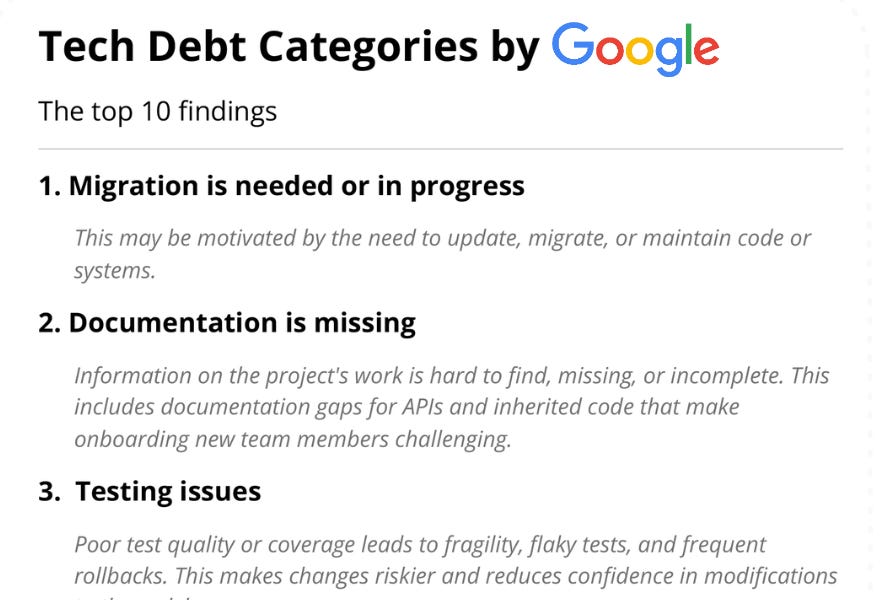
Happy Monday! ☀️
Welcome to the 363 new hungry minds who have joined us since last Monday!
If you aren't subscribed yet, join smart, curious, and hungry folks by subscribing here.

📚 Software Engineering Articles
How to automate client work so you can focus on real engineering
Master session management with cookies and tokens for better security
How Google handles tech debt efficiently in its engineering teams
Learn about 5 core distributed concepts every developer must understand
Revolutionary web performance tips to speed up your site
Discover how Cursor indexes codebases lightning fast
🗞️ Tech and AI Trends
Apple partners with Anthropic to build a revolutionary coding platform
Uber expands robotaxi service to 15 new cities
Stripe launches stablecoin accounts in over 100 countries
👨🏻💻 Coding Tip
Use Go's select with a timer for graceful timeouts in concurrent operations
Time-to-digest: 5 minutes
Big thanks to our partners for keeping this newsletter free.
If you have a second, clicking the ad below helps us a ton—and who knows, you might find something you love.
💚
There's nothing artificial about this intelligence
Meet HoneyBook—the AI-powered platform here to make every client relationship more productive and prosperous.
With HoneyBook, you can attract leads, manage clients, book meetings, sign contracts, and get paid.
Plus, HoneyBook AI tool summarizes project details, generates email drafts, takes meeting notes, predicts high-value leads, and more.

Node.js powers millions of backend applications by executing JavaScript code through an event loop with multiple specialized phases. Understanding how it works internally is crucial for writing performant server-side applications that handle concurrent operations efficiently.
The challenge:
A runtime that can process async operations like file I/O and network requests without blocking while maintaining predictable execution order across different types of operations.
Implementation highlights:
Event loop phases: Multiple specialized phases (timers, poll, check etc.) to handle different types of operations efficiently
libuv integration: C library that provides cross-platform async I/O operations and event loop implementation
Poll phase optimization: Blocks efficiently waiting for I/O events rather than spinning the loop
process.nextTick: Special queue that runs after each phase for fine-grained control
Promise microtasks: Lower priority than nextTick but higher than macrotasks for predictable async execution
Results and learnings:
Efficient I/O: Non-blocking handling of file and network operations
Predictable order: Well-defined phase sequence ensures consistent execution patterns
Developer-friendly: Familiar JavaScript APIs while handling complex async operations under the hood
Node.js shows that with careful system design, we can build powerful server-side applications using JavaScript. Understanding the event loop phases helps write better code by working with the runtime rather than against it.

ARTICLE (impact and taste for devs)
Impact, Agency, And Taste
ARTICLE (diagrams for concurrency)
Concurrency Diagram
GITHUB REPO (surf the web with sense)
SurfSense: Open Source Alternative to NotebookLM
GITHUB REPO (void the editor)
Void Editor
ARTICLE (HTML includes mystery)
Seeking an Answer: Why can't HTML alone do includes?
ARTICLE (anubis saves the day)
The Day Anubis Saved Our Websites From a DDoS Attack
ARTICLE (web speed hacks 2025)
14 Web Performance Tips for 2025
ARTICLE (powerpoint hacking)
Reverse Engineering PowerPoint's XML to Build a Slide Generator
ARTICLE (LLMs are not magic)
As an Experienced LLM User, I Actually Don't Use Generative LLMs Often
ARTICLE (getting things done in big tech)
Getting Things "Done" in Large Tech Companies
Want to reach 180,000+ engineers?
Let’s work together! Whether it’s your product, service, or event, we’d love to help you connect with this awesome community.

Brief: Apple partners with Anthropic to develop an AI coding tool using Claude Sonnet for writing, editing, and testing code, potentially integrating it into Xcode for internal use first.
Brief: Uber doubles down on autonomous vehicles with a $100M investment in WeRide to expand their robotaxi partnership to 15 more cities, focusing on Europe and beyond.
Brief: Google's latest Gemini 2.5 Pro update significantly improves the AI model's coding performance, making it more efficient and accurate for developers.
Brief: Stripe now enables merchants in 100+ countries to hold and transfer funds via stablecoins (USDC and USDB), accelerating cross-border payments and deepening its fintech ecosystem.
Brief: Amazon unveils Vulcan, a touch-sensitive warehouse robot that handles 75% of inventory items, operates 20 hours/day, and aims to reduce worker injuries—but insists it’s not replacing humans.
Brief: Figma introduces AI-driven "vibe-coding", allowing users to generate functional app and website code from text prompts or existing designs, with premium access starting at $16/month and integration of Anthropic’s Claude AI model.

This week’s coding challenge:
This week’s tip:
In Go, use select with a default case and a timer to implement graceful timeouts for concurrent operations while still processing results that arrive within the time window. This pattern provides more control than context-based timeouts and allows partial results to be handled.

Wen?
Distributed systems: Collecting partial results from multiple services when complete responses aren't critical.
Resource cleanup: Gracefully shutting down goroutines while still processing in-flight requests.
Batch processing: Implementing "process as much as possible within time window" scenarios.
“Life without love is like a tree without blossoms or fruit.”
Kahlil Gibran


That’s it for today! ☀️
Enjoyed this issue? Send it to your friends here to sign up, or share it on Twitter!
If you want to submit a section to the newsletter or tell us what you think about today’s issue, reply to this email or DM me on Twitter! 🐦
Thanks for spending part of your Monday morning with Hungry Minds.
See you in a week — Alex.
Icons by Icons8.
*I may earn a commission if you get a subscription through the links marked with “aff.” (at no extra cost to you).









